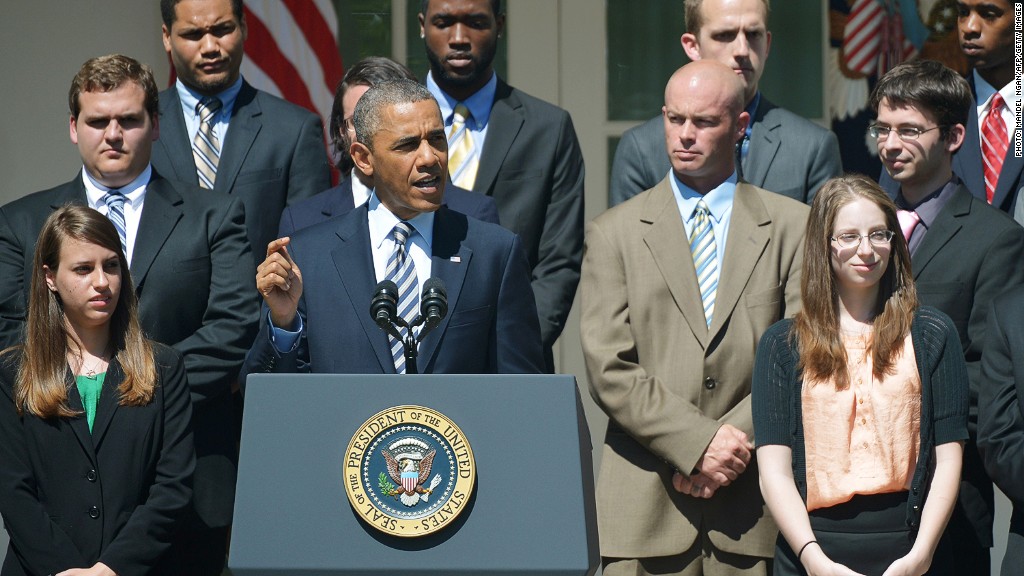
On July 1, the interest rates on student loans subsidized by Uncle Sam will most likely double to 6.8%.
Congress and the White House agree that something should be done, but they don't agree on what. The Republican-controlled House passed a bill last week that would stop the rates from doubling now but allow them to rise later. Obama vowed to veto it. On Friday, Sen. Harry Reid said the Senate would vote next week to extend the current rate for two more years.
If this sounds familiar, it is. Last year, facing a July 1 deadline, Congress put off any tough decisions and kept rates the same. In a press event Friday, President Obama blamed Congress for another round of interest rate roulette.
"I'm glad the House is paying attention to it, but they didn't do it in the right way," said Obama.
Nonetheless, Obama's proposal is not dramatically different from the House bill. Under both plans, students would see interest rates rise significantly in coming years.
Related: GOP resists White House effort to control message
What's at stake?
7 million undergraduate students taking out subsidized loans for the 2013-2014 school year will face bigger balances when they start paying off their loans after graduation.

The rate hike will only affect undergraduates who have subsidized loans, in which the federal government absorbs some of the interest rate. This makes up about a third of undergraduate loans, which are awarded based on economic need.
Far more undergraduates take out unsubsidized loans, whose rates have been at 6.8% since 2007. These interest rates will remain the same for most middle-class undergraduate and graduate students.
What would the Republican House plan do?
The House plan sets interest rates for all students at around 5%. That's a hike for undergraduates taking out subsidized loans but a break for undergrads and graduate students who have unsubsidized loans.
However, these rates would change once a year. The rates are based on the 10-year Treasury yields, now hovering around 2.1% but expected to rise in coming years. The House would add a 2.5% mark-up to cover the cost of running the plan.
The big change from current policy is that students can't lock in their interest rates until they graduate, but there is a cap that prevents rates from rising above 8.5%.
Upside: Loans are cheap now because rates are low. Downside: Rates could get close to that 8.5% cap in later years, as the Congressional Budget Office has predicted.
What would Obama's plan do?
Under Obama's plan, all students would benefit from taking out cheaper loans this year. Rates would be 3% for undergraduate students taking out subsidized loans, and 5% for all others.
Obama would also link the rates to 10-year Treasury yields, plus a mark-up to cover the cost (1% for subsidized loans and 3% for unsubsidized). The rates would change once a year. But unlike the House bill, the rates are locked in while students are in school, which is how it works now. But this plan doesn't set a cap on student loan interest rates.
Obama would keep payments low by encouraging students to enroll in a new repayment program, which limits monthly loan repayments to 10% of the borrower's annual income after taxes and basic living expenses. The debt is forgiven after 20 years or 10 years for those in public service or nonprofit jobs.
Upside: Loans are cheap now because rates are low. Downside: With no cap, interest rates could skyrocket in later years.
Related: Class of 2013 grads average $35,200 in total debt
What would the Senate Democrats' plans do?
Next week, the Senate will vote to extend current low rates for another two years. However, House lawmakers have said they wouldn't consider another extension.
There are several other Senate proposals, the most prominent of which is by Sen. Jack Reed. This bill would lower rates for all students to as little as 2.1%, which would rise in subsequent years. The rate would be capped at 6.8% for subsidized loans and 8.25% for unsubsidized loans.
Reed's bill would base student loans on the 91-day Treasury bill rate, currently at .045%, plus the cost of running the program. While that cost now runs around 2 percentage points, Reed gives the Department of Education the power to set the mark-up.
Upside: Students are all but guaranteed cheap loans. Downside: Federal deficits would rise, but Reed's proposal would get rid of tax breaks for the oil industry to pay for it.
What's next?
Stay tuned. Congress will be debating the various plans and, no doubt, throwing a lot of sticks and stones at one another along the way. It's not clear how it will play out in the end, but it doesn't look good for students.
